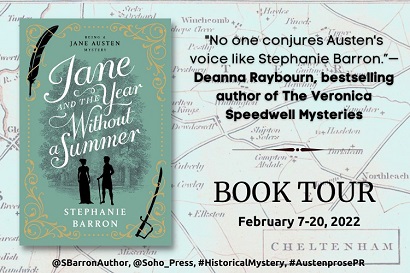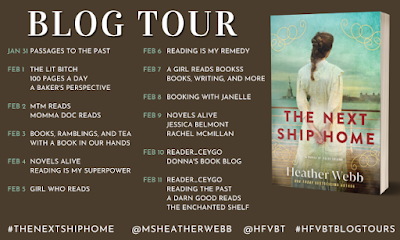Thanks to author Heather Webb for stopping by Reading the Past for an interview about her new novel The Next Ship Home (Sourcebooks, Feb. 2022), which offers a unique lens on the American immigration story. Through the perspectives of two young women in the early 20th century -- aspiring translator Alma, the daughter in a German family who becomes a matron at Ellis Island, and Francesca, a newly arrived Italian immigrant -- I was quickly drawn into a sweeping story about cultural prejudice, corruption, the complications of family, and a surprising friendship.
I’ve read many historical novels dealing with immigration to America, but yours is the first that centered on operations at Ellis Island itself. All the details were fascinating to read about. What inspired you to focus your attention on what took place there?
The very first time I visited Ellis Island I was a high school teacher on a field trip with students. I was absolutely riveted by the place. There’s a real presence in those halls…so many people, so many stories to be told. I think, also, being a lover of language and culture—and a military brat—has always made the study of those trying to assimilate to a culture not their own has always fascinated me. I could relate in many ways. It’s funny that when I first started writing, I knew I wanted to write a book about Ellis Island but I also knew I wasn’t ready. Something inside me warned me that I needed to practice more, try other books and ideas, before it was time to sit down and tackle such a grand, challenging topic. I’m glad I listened to my intuition.
What resources did you use to re-create the duties and mindset of Alma, a matron at Ellis Island whose job involved assisting female immigrants and families?
I read several books about the operations at Ellis Island and I also mined information from a ton of immigrant interviews. Though there weren’t a lot of specifics on the day-to-day of a matron, there was just enough that I could glean the basics and fill in the rest. I also found helpful information on the plaques and in the videos at the immigration center on Ellis Island.
As a language aficionado myself, I rooted for Alma and her yearning to become a translator. I also enjoyed seeing her improve her repertoire of world languages, and the theme of how languages are a bridge to cultural understanding. How did you get interested in this topic?
I’m a former French and Spanish teacher and I thoroughly love language-learning in all its forms. I’m really fascinated by the way language reflects culture and how, in kind, culture shapes language. I enjoy studying how language has changed over time as well. I suppose you could say Alma was my ode to the language teacher inside me.
How did you decide on the approach to tell the story from two women’s alternating perspectives?
I knew I wanted to explore different classes of Americans from the newly-arrived immigrants to the first-generation Americans, as well as the wealthy, more established. As well, I wanted to depict the opposing perspectives of immigrant and worker to show the complexity of the immigration system. It’s very rarely a simple thing.
Ellis Island is enshrined in many family histories as a place of hope and new beginnings. Human nature being what it is, I shouldn’t have been surprised at the corruption and abuse that took place at Ellis Island, and which the immigrant characters unfortunately deal with. Were there any facts that took you by surprise as you researched this aspect of the novel?
 |
| author Heather Webb |
Many! I really enjoyed reading about Teddy Roosevelt’s place in shaping immigration reform as well as his visit to the island in the fall of 1903. It was a horrible, stormy day and the boat carrying him and his staff nearly capsized in the swell of the bay. When he arrived to the island, very late to the elaborate lunch they’d planned, the food was cold but they did manage to serve oysters for which the Hudson Bay used to be famous, and also champagne. There are so many more facts, too, about the anarchists like Emma Goldman, President McKinley’s assassination, and much more. In truth, I had a hard time narrowing down what the story was truly about during the first few drafts.
Reproducing international languages and accents in dialogue can be tricky, because the effect can easily be overdone, but this isn’t the case with Francesca. Everything read as very natural to me. What suggestions do you have for other authors about writing dialogue for characters still gaining fluency in English?
First of all, thank you for the compliment. It’s not an easy thing and yet, I think it’s important to distinguish differences in the characters’ language. I’m a freelance editor and teacher as well so I usually recommend to my students to think of dialect and foreign language as a seasoning in a dish. Salt makes a dish delicious with just the right amount but it must be sprinkled with caution. Too much makes the dish inedible.
Since The Next Ship Home takes place in the United States, did you find the research any easier or different than it was for your previous novels?
Overall, I’d say it wasn’t easier because I’m always interested in international travel and I’m the first one on that plane, but it’s certainly true that living not far from New York City made my research much more accessible (and cheaper!). I took many trips to Ellis Island and into the city itself, and I also used the public library and its archives in the city to gather information and photos, trinkets, etc.
About the author:
Heather Webb is a
USA Today bestselling and award-winning author of historical fiction. In 2017,
Last Christmas in Paris won the Women’s Fiction Writers Association award, and in 2019,
Meet Me in Monaco was shortlisted for both the RNA award in the UK and also the Digital Book World Fiction prize. Heather’s new solo novel
The Next Ship Home is about unlikely friends that confront a corrupt system, altering their fates and the lives of the immigrants who come after them. When not writing, Heather flexes her foodie skills, geeks out on pop culture and history, or looks for excuses to head to the other side of the world.
For more information, please visit
Heather’s website.
























